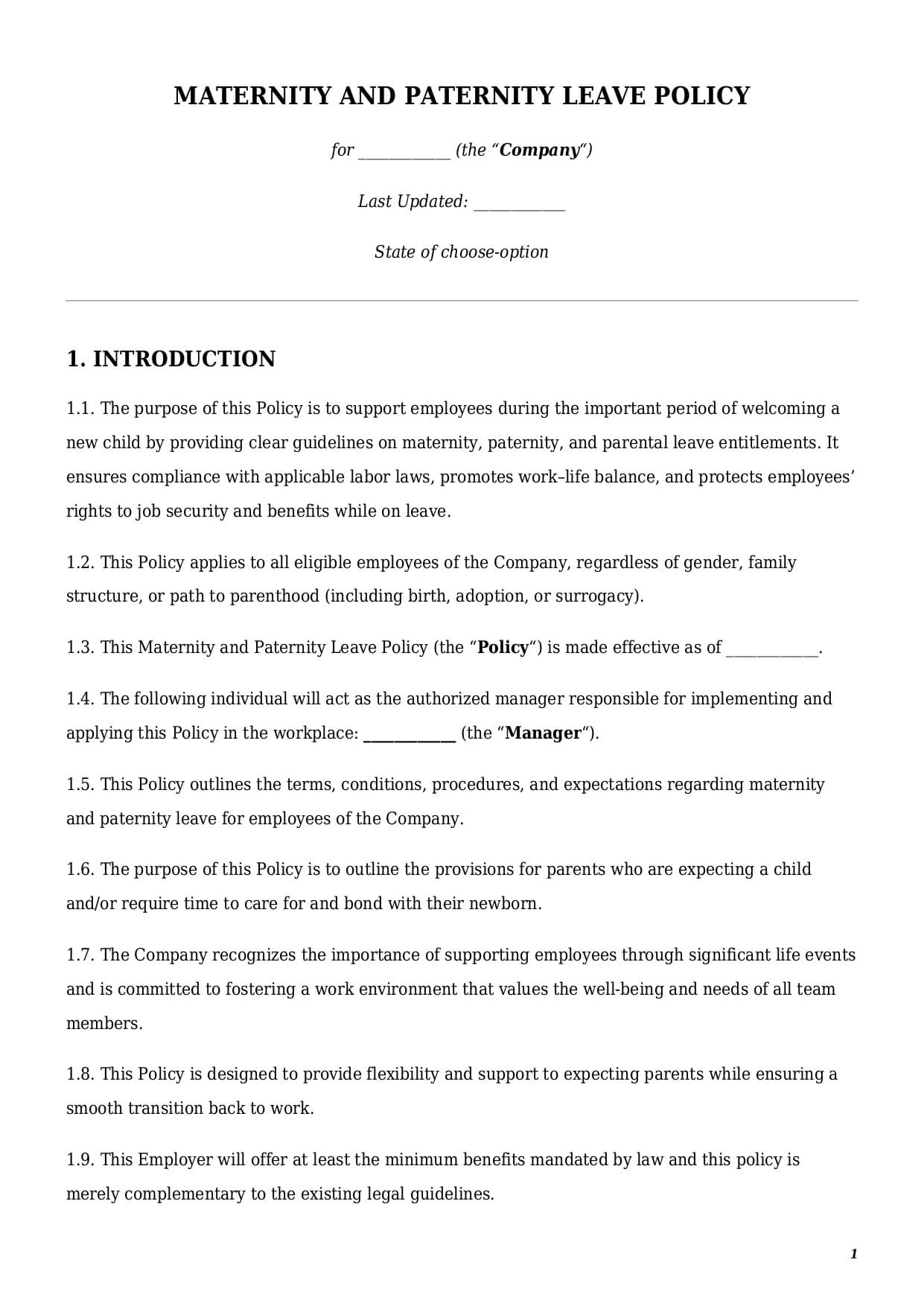Maternity and Paternity Leave Policy
Reviews


What is a parental and maternity policy?
A parental and maternity policy template is a company’s internal document that sets out clear rules and procedures for granting time off to employees who are becoming parents. This policy intends to cover a number of important aspects, including:
- categories of employees who are eligible and ineligible for leave;
- available types of leave;
- leave request procedure;
- policy’s modification procedure, etc.
Small businesses, startups, mid-sized employers, and nonprofit organizations operating in the U.S. can use this maternity and parental leave policy template. Having this document is a must for every organization to ensure legal compliance and a secure environment for all employees.
This template could be used in conjunction with other policies, including:
Top 4 important things for a parental and maternity policy
When drafting a maternity and parental leave policy template, inclusion of certain components is essential. Failure to include them may result in a document being incomplete or a violation of applicable federal or state regulation.
Policy’s Scope of Application
Whether you need a non-paid or paid parental leave policy template, the text of a document shall clarify to whom this policy could apply. Knowing who can be eligible for a maternity, parental, or paternity leave is key for the smooth operation of a business, as well as compliance with state regulation.
Businesses and organizations may limit application of the leave policy to either one or several categories of employees listed below:
- full-time employees;
- part-time employees;
- interns and volunteers;
- seasonal employees; and/or
- contractual workers.
To be eligible for a leave, employees or contractors should have existing employment agreements.
Definitions
The topic of maternity and parental leave is both sensitive and complicated at the same time. Clarifying terminology in the text of a maternity leave policy template is key for its successful application. And here is why:
- First, clear terminology prevents ambiguity in the policy’s application. Ambiguity can lead to situations where one employee receives different leave benefits than another in the same circumstances.
- Second, clear policy terms ensure an uninterrupted and smooth working process and a fair balance between employees’ rights and the business’s needs.
Procedure to Request Leave
Well-drafted paid maternity or paid parental leave examples of policies lay out the detailed procedure for requesting the leave.
Therefore, the text of the template must include the following important components:
Notice Period
A minimum required period of time within which an employee shall provide an advance notice with the intent to take the leave. The minimum notice period is usually 30 days, though big organizations with hundreds of employees may establish longer notice periods to ensure a smooth working process.
Compliance Officer
A specially appointed person within the organization who is in charge and oversees general application of parental and maternity policy. This could be someone from a compliance or HR department. Usually, this is a person who receives all requests for a leave, as well as in charge of clarifying the application of the leave policy within the organization.
Request Documentation
A list of all information an employee shall provide along with their request for leave. A maternity leave policy template shall not only define the requirements for the leave request itself but also list supportive documentation (e.g., a medical certificate confirming pregnancy).
Approval Procedure
A detailed step-by-step process of internal discussion, along with a leave’s further approval or rejection. A solid parental leave policy template should always define the exact timeline within which a final decision should be delivered. Apart from that, it is worth also including a list of specific grounds on which the provision of the requested leave could be rejected. Those grounds may include ineligibility to apply for the leave (e.g., when a future father requests PDL) or when an employee has not worked the minimum required time in the company, etc.
Return-to-work process
A set of clear rules and guidelines on the return and accommodation of an employee after their leave.
Confidentiality
An employer’s obligation to refrain from disclosure of any employee’s personal, medical, and other sensitive information.
Types of Leaves and Their Duration
A comprehensive parental and maternity policy template shall define available types of leave as well as their duration. The types of leave that could be provided to employees are the following:
Pregnancy Disability Leave (PDL)
A state-protected leave every pregnant employee can apply for to take a rest before the delivery, to attend medical appointments, or due to other related medical conditions. This leave is mandatory, and an employer cannot refuse to provide it. A PDL should be granted in case of a normal delivery or for surrogacy. The maximum duration of the leave is up to 4 months. The federal law does not oblige businesses to provide paid pregnancy disability leave. Thus, applicable state regulation should be checked further to find out if an employee may request a paid PDL and its duration.
Family and Medical Leave (FMLA)
A state-protected leave that should be provided by each business and organization with 50+ employees. FMLA is an unpaid leave, and its maximum duration shall not exceed 12 weeks (or 26 weeks for military caregivers). If you are a business or organization with less than 49 employees, you are not obligated to grant that type of leave to your employees. To be eligible for FMLA, an employee shall work at least 12 consecutive months in the organization prior to applying for this type of leave. This leave could be used to take care of a newborn or sick family member or to undergo serious medical treatments.
Maternity and Paternity Leave
A state-protected leave for parents of a newborn child to be able to take care of the newborn and to bond. This type of leave could be granted only to biological parents of a child. Most small business maternity leave policy templates do not provide paid leave in that case. However, bigger businesses tend to offer at least a few weeks of paid leave in that case.
Parental Leave
A state-protected inclusive leave for adopted parents, non-birthing parents (including same-sex marriage or parents giving birth to their child through surrogacy), as well as foster parents. This is a guaranteed 12 weeks of unpaid, job-protected leave for employees. Some organizations may adopt paid parental leave policy templates for some categories of employees (e.g., those who work for a long period of time in the company).
How to customize a maternity leave policy template at Faster Draft?
To get a fully customized policy template, follow a few easy steps below:
- Click the button “Create Document.”
- Answer simple questions in the form.
- Select a template’s format—Maternal and Paternity Leave Policy PDF or Word.
- Make a payment.
- Download and use a personalized policy for your organization, company, or business.
Table of content
Frequently Asked Questions (FAQ)
-
1. Can I get a paid maternity leave in California?
California is amongst the few states within the United States that adopted a mandatory paid maternity leave for employees working in California. Thus, California’s parental leave policy should always specify the minimum amount of paid days of maternity leave an employee can get.
According to the State Disability Insurance program, employees in California are eligible for up to 6 weeks of paid maternity leave. The compensation varies between 70 and 90% of an employee’s weekly or monthly wage. The exact amount of compensation, as well as the allowed paid maternity leave, shall be clarified directly with the employer or organization an employee currently works for.
-
2. Can a partner in a same-sex marriage apply for a paid paternity leave?
Paternity leave is a state-protected leave that is granted to a non-birthing parent to care for and bond with their newborn child.
A non-birthing partner in a same-sex marriage is eligible for a parental leave. Parental leave is more inclusive state-protected leave that should be granted to extended family members, like non-birthing partners, adoptive parents, and surrogacy parents.
Some employers may offer a paid parental leave policy for the non-birthing parent in a same-sex marriage, while others don’t. To find out if you are eligible specifically for a paid parental leave, it is better to consult directly with the organization or business you are currently working for.

Looking for something Different?
Start typing to find out our collection of legal documents and contract templates
